Few things draw attention to your garden like ornamental grasses waving in the breeze. It’s almost as if the grasses are welcoming visitors. Residents of USDA Plant Hardiness Zone 5 should consider the needs of their specific climate when choosing ornamental grasses for their garden. In Zone 5, the average minimum winter temperatures range between -20 to -10 Fahrenheit degrees. Let’s take a look at some ornamental grasses that thrive in Zone 5.
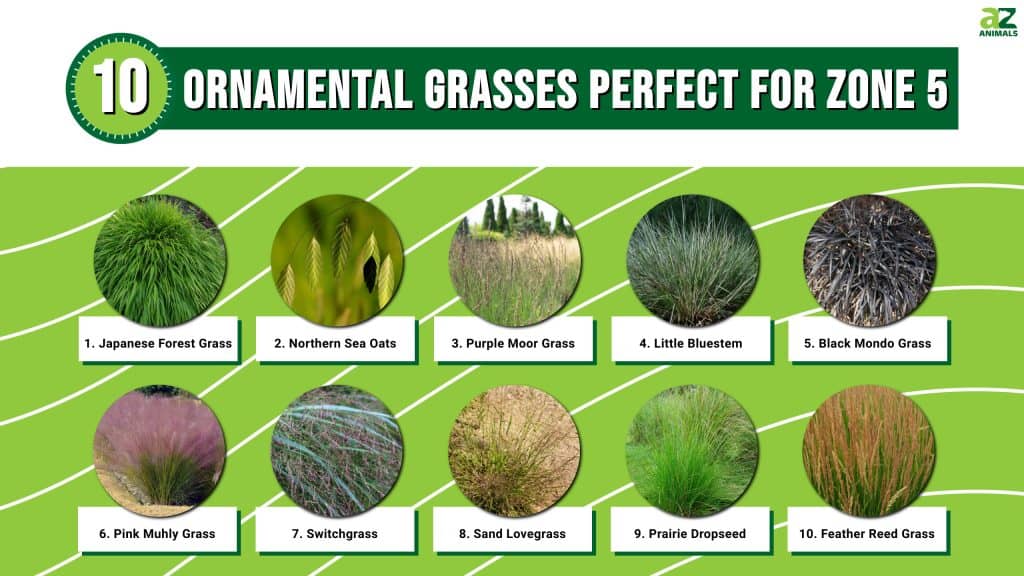
Where is Zone 5?
Zone 5 is expansive, taking up portions of Alaska, California, Colorado, Connecticut, Idaho, Illinois, Indiana, Iowa, Kansas, Maine, Maryland, Massachusetts, Michigan, Minnesota, Missouri, Montana, Nebraska, Nevada, New Hampshire, New Mexico, New York, Ohio, Pennsylvania, South Dakota, Utah, Vermont, Virginia, Washington, West Virginia, Wisconsin, and Wyoming.
1. Japanese Forest Grass (Hakonechloa macra)
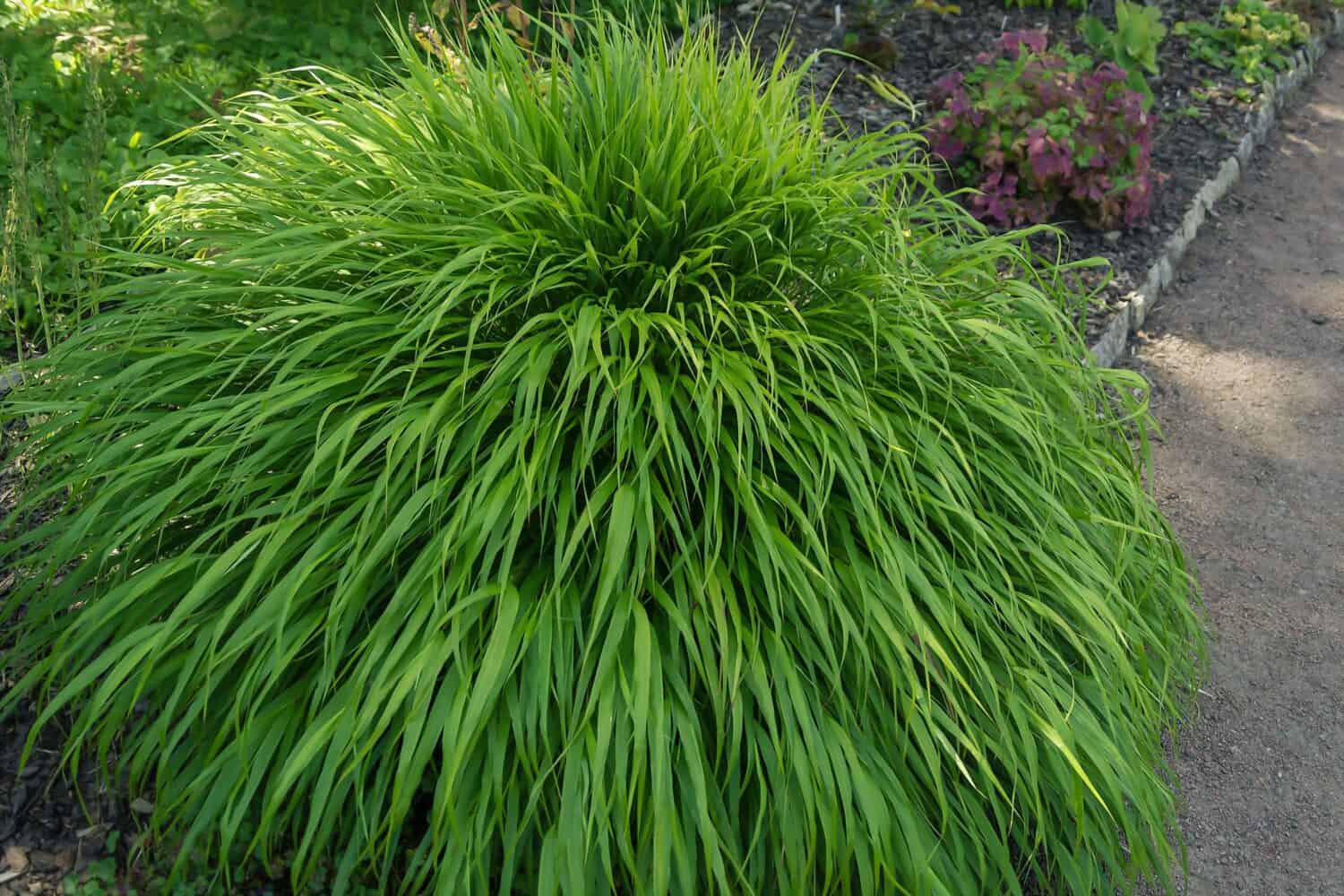
Japanese forest grass is native to the mountainous areas of Tokaido in Honshu, Japan.
©oroch/Shutterstock.com
Used primarily as an accent or border plant, Japanese forest grass draws visual interest to outdoor spaces with its long thin leaves. This grass grows in mounds, leading some gardeners to plant it among rocks so the leaves can spill over them. Japanese forest grass reaches, on average, a height of 12-18 inches tall and one to two feet wide. Unlike many other ornamental grasses, Japanese forest grass performs extremely well in either full or partial shade. Unobtrusive yellow-green flowers bloom during the summer. When planted in partial shade, the leaves become variegated with yellow and green stripes. In full shade, Japanese forest grass may remain solid green. However, Japanese forest grass is susceptible to scorching if planted in full sun. Don’t leave Japanese forest grass out of your regular watering schedule! Japanese forest grass requires rich, moist soil. Mulching helps the plant retain moisture while providing important nutrients. Amending poor soil with mulch or compost helps Japanese forest grass thrive.
2. Northern Sea Oats (Chasmanthium latifolium)
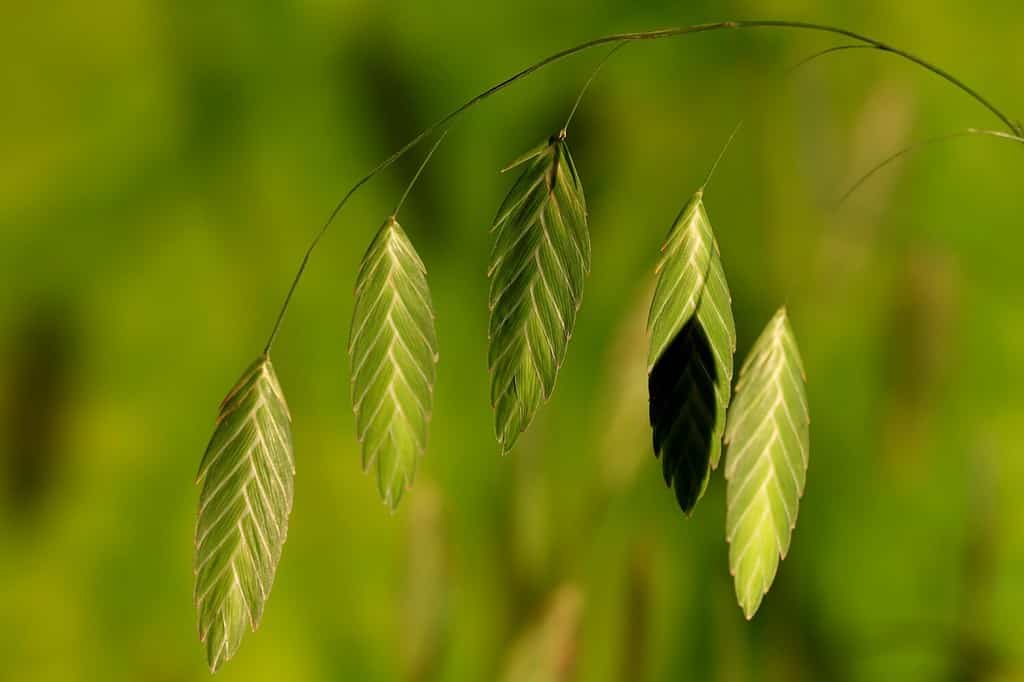
Seeds from Northern sea oats are edible and can be used in baking.
©Scorsby/Shutterstock.com
Attractive from late summer into winter, Northern sea oats are a gorgeous addition to outdoor areas in Zone 5. When it blooms sometime around June, the northern sea oat develops a greenish seed head that droops from thin stems. After the frost, the seed heads turn beige before falling from the plant. Those stalks are excellent for use in a dried flower arrangement. Northern sea oats require moist soil and thrive in full to partial shade. Full sun exposure causes the leaves to turn yellow. Northern sea oats grow in clumps and have a tendency to reseed. Collect seeds in the fall to reduce the risk of unwanted spreading.
3. Purple Moor Grass (Molinia caerulea)

It can take purple moor grass up to five years to reach full maturity.
©AliScha/Shutterstock.com
Widely utilized as an accent plant, purple moor grass is pretty to look at from summer to fall. Purple moor grass grows to between four and eight feet high. In July, small graceful flowers appear on the tall stems of purple moor grass. Those blooms last until September when the foliage turns a golden brown and the flowers fade. Purple moor grass does well in full sun or partial shade. This plant prefers soil that is moist and well-drained. Once established, purple moor grass is somewhat tolerant to drought. Wait until late winter or early spring to remove dead foliage. Purple moor grass self-seeds and can take over large areas if left unchecked.
4. Little Bluestem (Schizachyrium scoparium)

In the winter, little bluestem seeds are a food source for birds.
©Michael G McKinne/Shutterstock.com
Taking its common name from its bluish stems, little bluestem is a useful and attractive ornamental grass. Little bluestem grows in clumps that grow one to two feet high. In late summer, wispy feather-like white flowers appear on the stems. As fall approaches, the stems change color from blue to red. That color remains throughout the winter. Little bluestem prefers full sun and dry soil. Once well established, this prairie grass is drought tolerant. Its expansive root system helps prevent soil erosion. However, little bluestem is a copious reseeder. Give little bluestem room to expand because it will crowd out smaller plants.
5. Black Mondo Grass (Ophiopogon planiscapus ‘Nigrescens’)
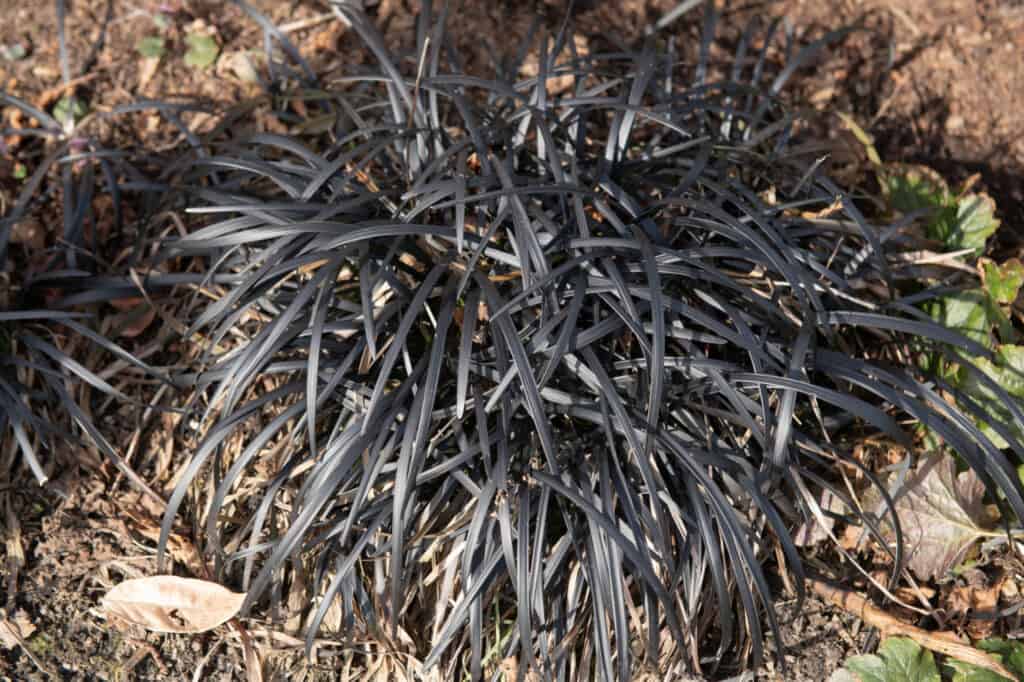
Consider using black mondo grass as a container plant.
©Peter Turner Photography/Shutterstock.com
Adding a fascinating element of darkness to Zone 5 gardens, the leaves of black mondo grass exhibit purplish-black coloration. Planting black mondo grass among plants of lighter colors creates an eye-catching contrast. Black mondo grass grows in low clumps, reaching up to eight inches tall. An evergreen perennial, black mondo grass requires an average amount of water to thrive. Plant black mondo grass in well-drained sandy or loamy soil where it will receive full sun exposure to partial shade. In the fall, black mondo grass produces small purple berries. Black mondo grass is non-toxic, so don’t worry if you see your cat or dog eating a few of the berries or leaves.
6. Pink Muhly Grass (Muhlenbergia capillaris)
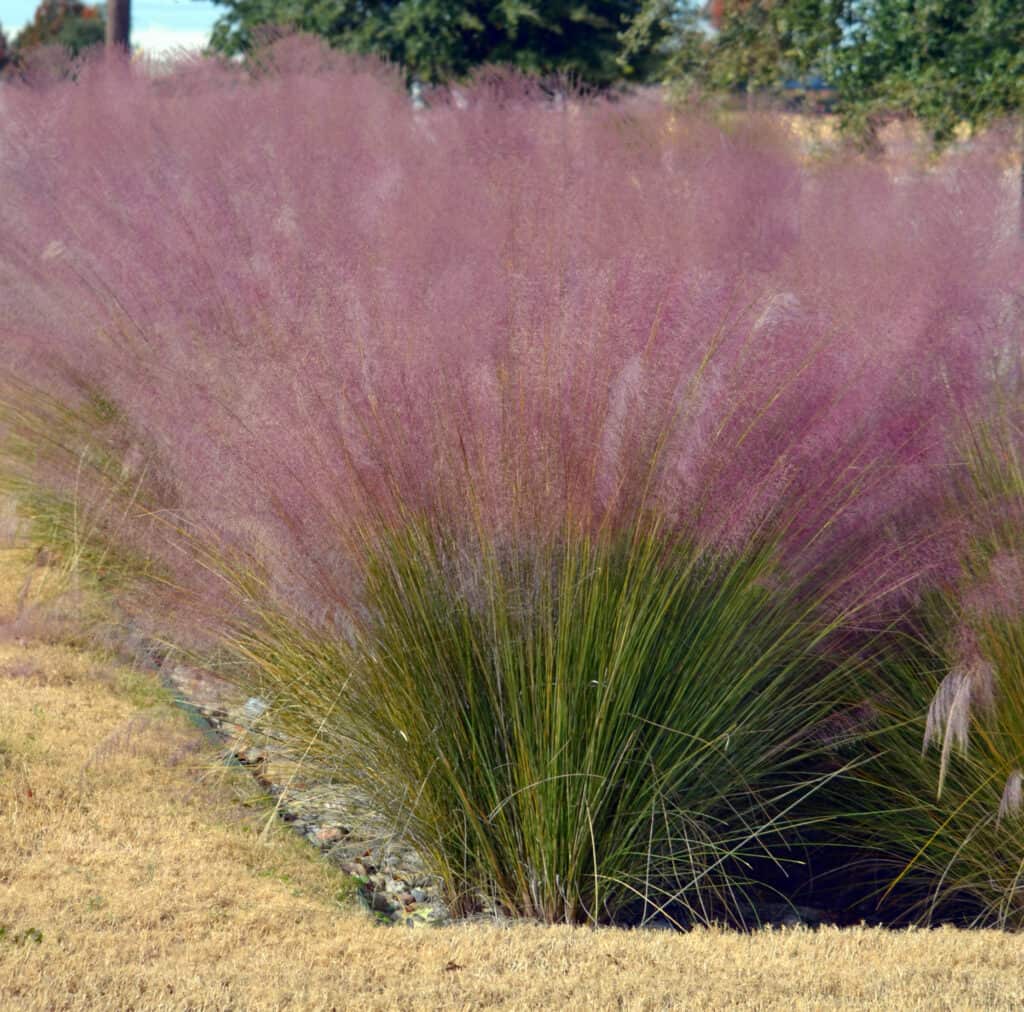
Animals that build nests, like rabbits and birds, are attracted to pink muhly grass.
©MaryAnne Campbell/Shutterstock.com
With its tall fluffy plumes, ranging in color from vibrant pink to lavender, pink muhly grass is a showy and dramatic plant. Pink muhly grass grows up to four feet tall and three feet wide. This plant’s hallmark pink flowers begin to appear in late summer to early fall. In the winter, pink muhly grass develops visually interesting tan seed plumes. Mature pink muhly grass plants don’t require much special maintenance. Full sun or minimal shade conditions allow pink muhly grass to grow to its maximum potential. Pink muhly grass does well in sandy or rocky soil. When mature, pink muhly grass is tolerant of heat, drought, and humidity. Space pink muhly plants at least four feet apart when planting to allow air to circulate. Pink muhly plants are susceptible to tar spots, a fungal disease if planted too close together.
7. Switchgrass (Panicum virgatum)
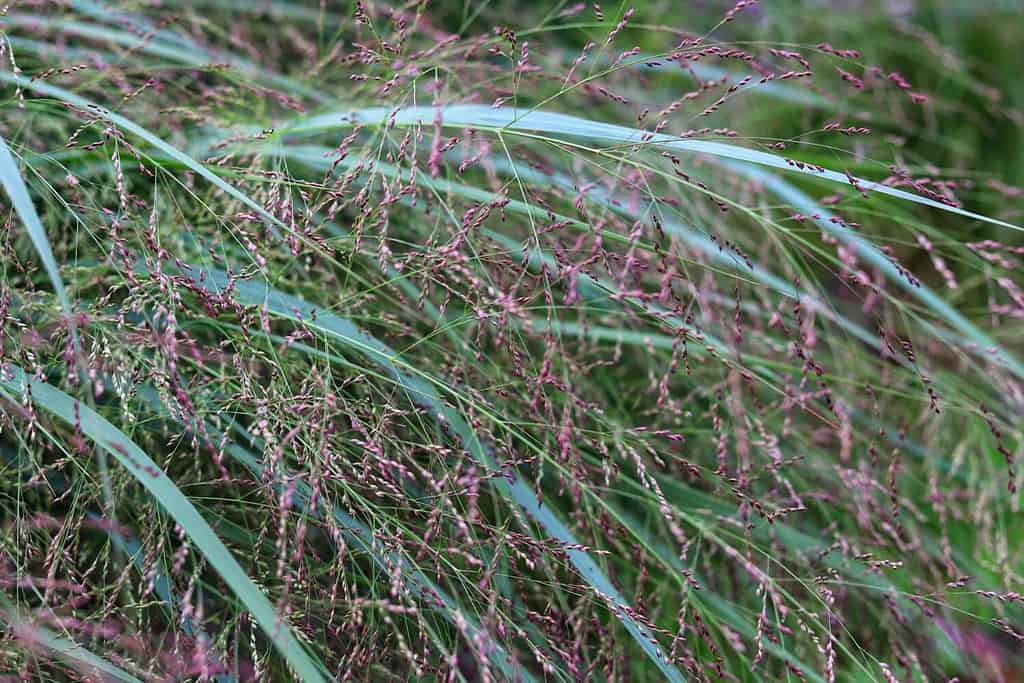
Research has been conducted to calculate the potential of switchgrass as a biofuel source.
©Kabar/Shutterstock.com
Found growing wild in some areas of Zone 5, switchgrass is utilized as a tall ornamental grass in gardens and landscaped areas. Switchgrass reaches heights of five feet tall, making it an excellent focal point for outdoor spaces. Because its root systems extend into the earth as deep as six feet, switchgrass is employed to minimize soil erosion. Switchgrass resists flopping over in the winter. In midsummer, switchgrass displays small pinkish flowers at the top of its stems. Colder weather makes the foliage turn shades of yellow or beige. Switchgrass grows in a wide variety of soil conditions but flourishes with moist soil and full sun.
8. Sand Lovegrass (Eragrostis trichodes)

Foraging livestock enjoy eating sand lovegrass, leading to the plant being nicknamed “ice cream grass.”
©Marinodenisenko/Shutterstock.com
If you’re gardening in sandy soil in Zone 5, sand lovegrass is a perfect choice. Sand lovegrass reaches heights up to five feet, making it an excellent medium-sized plant for outdoor spaces. It grows in tufts that have a tendency to flop over, creating the potential for beautiful spilling effects. From July to August, sand lovegrass displays small purple flowers. Plant sand lovegrass in sandy soil where it will receive full sun. Both drought and heat-tolerant, sand lovegrass has minimal water needs.
9. Prairie Dropseed (Sporobolus heterolepis)

Seeds of the mature prairie dropseed are fragrant with an aroma reminiscent of coriander.
©ANECEPTIUS BAMBANG SUTOPO/Shutterstock.com
Patience is required when growing prairie dropseed. It could take up to two years for prairie dropseed to become well-established. Prairie dropseed loves full sun and dry soil, making it a low-maintenance plant. However, prairie dropseed thrives in a variety of soil conditions. Look for seed heads to appear from July until September. In the fall, the seeds drop from the plant. Because it remains standing through snowfall, prairie dropseed is winter conspicuous. Prairie dropseed makes a great border plant for gardens or along walkways.
10. Feather Reed Grass (Calamagrostis x acutiflora ‘Karl Foerster’)
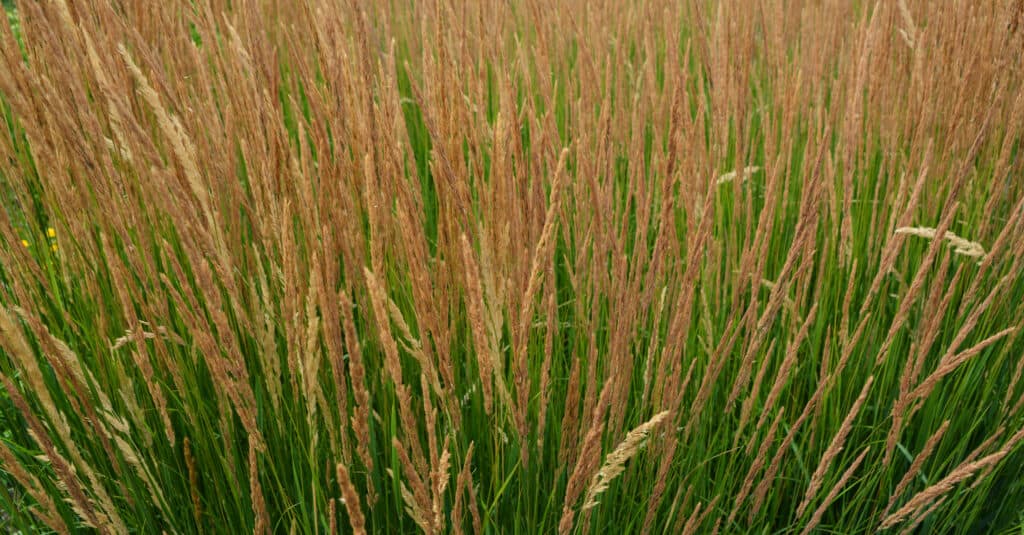
was named Perennial Plant of the Year in 2001 by the Perennial Plant Association.
©meunierd/Shutterstock.com
One of the most popular ornamental grasses, feather reed grass is a hybrid created from two members of the Calamagrostis (reed grass) genus. Gardeners and landscapers incorporate feather reed grass into outdoor designs because of its vertical growth pattern. In the spring, feather reed grass grows in clumps three feet tall. Six-foot-tall flower stalks erupt in early summer. Blooms begin by displaying a pink color, which deepens to red and bronze. Seed heads become tan as they mature, remaining that color throughout the fall. Because the seeds are sterile, feather reed grass cannot self-seed in the garden. Feather reed grass does well in full sun to partial shade. Plant feather reed grass in soil that remains moist. Cut feather reed grass down to the ground in late winter before new growth begins appearing.
Summary of 10 Ornamental Grasses Perfect for Zone 5
| Number | Plant name | Soil Conditions | Sunlight Requirements |
|---|---|---|---|
| 1 | Japanese Forest Grass | Rich, moist soil | Full sun to partial shade |
| 2 | Northern Sea Oats | Moist soil | Full sun to partial shade |
| 3 | Purple Moor Grass | Moist, well-drained soil | Full sun to partial shade |
| 4 | Little Bluestem | Dry soil | Full sun |
| 5 | Black Mondo Grass | Sandy or loamy well-drained soil | Full sun to minimal shade |
| 6 | Pink Muhly Grass | Sandy or rocky soil | Full sun to minimal shade |
| 7 | Switchgrass | Moist soil | Full sun |
| 8 | Sand Lovegrass | Sandy soil | Full sun |
| 9 | Prairie Dropseed | Dry soil | Full sun |
| 10 | Feather Reed Grass | Moist soil | Full sun to partial shade |
Thank you for reading! Have some feedback for us? Contact the AZ Animals editorial team.








